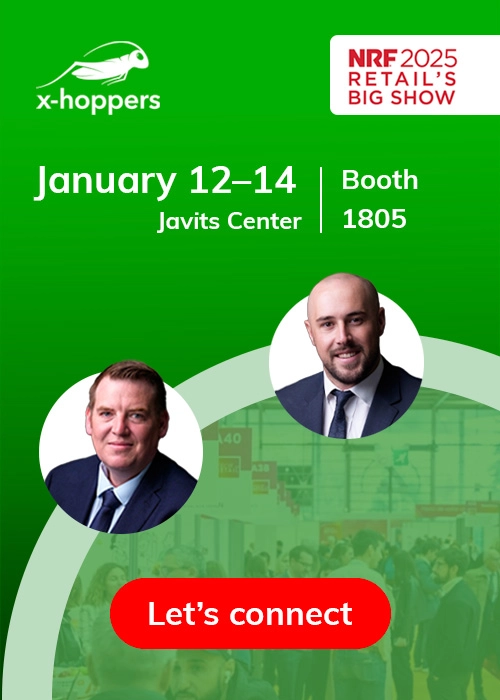
Creating an enjoyable in-store shopping experience seems straightforward. Everyone knows customers love friendly and knowledgeable store associates, full, priced and organized shelves and multiple ways to shop but often it’s a host of problems that make delivering the basics more problematic than it should be. Distracted by issues such as increasing theft and high staff turnover, retailers are sacrificing the customer experience right at a time when 90% of customer experience leaders are reporting that customer expectations are higher than ever.
And the thing is all the problems facing retailers eventually trickle down to the shop floor. You can’t build an excellent in-store experience if your staff is overstretched and large amounts of stock are missing from the shelves. As a result, your first step to cultivating exceptional customer service is to tackle internal problems and build more efficient processes, and to do that you need one thing: better in-store communication.
The Importance of Good Communication
Let’s imagine a scenario where a customer has stopped at their local supermarket to pick up a phone charger on their lunch break. They’ve been to the store many times before and know where the charger should be but the shelf is empty. They search for an employee and eventually find one who happens to be new. Unfortunately, the new starter knows nothing about the electronics section and can’t give the customer any additional information. Frustrated, the customer leaves the store empty-handed, deciding to shop at a competitor instead.
Even worse, when the new employee mentions it to another staff member they discover that there’s actually half a pallet of the item in the back, it was just never put out on the floor because it came in on a late delivery. If the new staff member had known the situation or could have quickly asked someone without leaving the customer’s side, they could have grabbed the item from the loading bay and the customer would have bought the item happily. As it stands, they might never visit that store, or chain, again.
It’s evident that better staff communication could have secured a sale, but let’s see how this particular scenario could be improved with a few key features from a unified retail communication system.
Internal Broadcast
A staple of in-store communication systems, an internal broadcast works as a secure voice channel where shop assistants are able to speak to the whole team at once. Traditionally, many retailers used walkie-talkies, but radio can easily be overheard by customers, which can impact the in-store experience. Ideally, you need a hands-free device, such as a headset or other in-ear device, so the conversation stays within the team.
But you don’t want a closed system that supports voice only. Communication shouldn’t just be limited to colleagues in-store. That means that other store units, back offices and even head offices should be able to speak to the frontline team just by picking up the phone. And if frontline workers can do the same from their headset, whether it’s to get clarification for a customer or ask for support, you suddenly have a communication system that unlocks the full potential of your employees regardless of where they are in the world.
Smart Call Points
Naturally, many customers will look for staff members when they have a question, but it isn’t always possible to have store associates on stand-by in every section of the store. Especially on early morning or late evening shifts, there are simply too many jobs and not enough staff members to go around.
That’s why call points can be helpful as they allow customers to signal they need extra support and when sent directly into a headset, can allow teams to quickly collaborate and redistribute tasks to both serve the customer and the store’s behind-the-scenes needs.
But what if you sell items such as household appliances that require specific product knowledge? Traditional call points just send a message, but smart call points using QR codes or tablets are much more flexible. While waiting for a store associate, the call point can bring up the product web page to instantly give them more information or, potentially, even call an expert in a call center or another store. This way you could provide the same level of service regardless of staffing levels or the size of the store.
Knowledge on Demand
Now, while some staff knowledge does require experience and extensive training, a good communication system can also provide the right information at the right time by offering knowledge on demand.
It can be as simple as connecting colleagues. If an associate gets a question regarding mattresses and they don’t know the answer, but they know the person who does, they can quickly reach out to their colleague to get an answer.
But what if it’s a small shop, like a convenience store, that only has one employee working on certain shifts? Well, if that employee is connected to a communications system with an AI assistant, they know they can find out product information just by asking the AI assistant a simple question, such as, “how many calories are in a slushy?”
In both cases, providing knowledge on demand not only allows employees to give the correct answer to customer queries but also gives them the confidence to engage with customers in the first place. Instead of shying away from customers, afraid they’ll ask a question the shop assistant doesn’t know, the assistant can approach shoppers knowing they have the tools and support they need to truly put the customer first.
AI Detection and Alerts
Ideally, you want to anticipate customer issues before they become problems. For example, when it comes to waiting times, customers will only wait about six minutes before abandoning a purchase, so it’s essential to get them the help they need as quickly as possible.
Connecting a headset communication system to a store’s self-checkouts means that the machines can immediately send a notification to staff to let them know when a customer has an issue scanning an item. This allows frontline workers to be there before the customer becomes frustrated with the process, moving them and the rest of the customers in line through the checkout much faster.
The same can be said for theft. With AI theft detection it is now possible to connect store associates to the in-store camera systems, sending them a message when a customer makes specific gestures that the AI classifies as suspicious. This allows staff to politely check in on customers, or check the area and pass a description on to the security team.
The clever thing about AI is that it is constantly learning to do more. So the same system can also detect if a person falls over or if a customer is waiting impatiently in a specific area of the store. All these could trigger alerts that staff members receive to help reduce customer wait time and also protect the bottom line by actively preventing theft and basket abandonment.
Finding the Right Solution
All the different features mentioned above are game-changing for improving communication between staff, systems and customers. They, however, require a communication system that goes beyond the capabilities of closed systems such as radios, handsets and common headsets. To really transform employee responsiveness, and, by extension, the customer experience, you need a communication system that is flexible enough to connect to the phone network, store systems, call points and AI technology. And at the moment the only system that fits the bill is x‑hoppers by Wildix.
x‑hoppers: Moving Beyond the Headset
Developed with retail in mind, x‑hoppers is a complete retail communication system that starts with push-to-talk headsets but is so much more. Through the headsets, it connects frontline employees to an internal broadcast where they can collaborate and receive automatic alerts from self-checkouts, smart QR call points, AI theft detection and other store systems. Since it’s powered by Wildix, a leader in the unified communications industry for over 20 years, x‑hoppers comes with full telephony and collaboration capabilities, allowing frontline staff to make and receive internal and external calls straight from the headset while also supporting a full suite of tools including chat and videoconference for back office staff and beyond.
Always forward-thinking, x‑hoppers has a flexible system that allows it to integrate with practically any system while native AI tools such as an AI assistant and AI theft detection ensure staff can respond to the challenges of a dynamic store environment and ever-changing customer needs.
Measuring Success
However, whatever communication tools you choose, remember that they are just that — tools. For x‑hoppers or any other solution to bring about real improvements to your customer service and in-store experience you need to continuously gather feedback and pinpoint areas of improvement.
This means not only investing in customer-facing surveys and scouring third-party review sites, but also taking the time to survey employees to discover where the underlying issues are. With all that information together, you’ll get a clear picture of what is actually happening in store units and the real problems you’re facing. And with a powerful communications system as your ally, you can work with your team to overcome those obstacles and continue to create an exceptional customer experience that will turn visitors into shoppers and shoppers into loyal customers.


